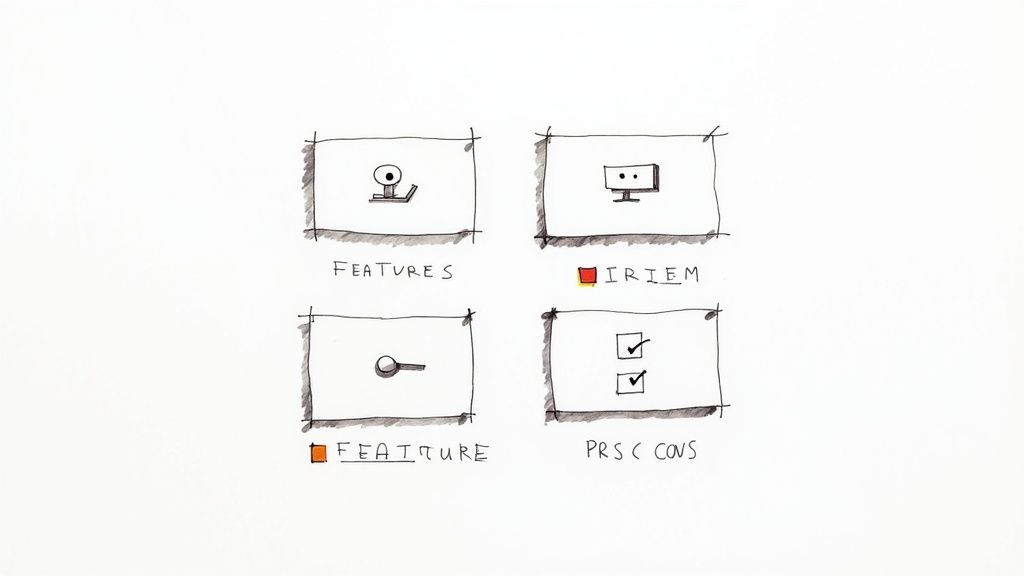Let's be honest. Most employee engagement surveys are a colossal waste of time. You ask vague questions, get vague answers, and then… crickets. You've got the fancy engagement platform, the free lunches, the ping-pong table you're still mortgaging, but people are still quiet quitting. Why? Because you're asking the wrong questions.
I've been there. I've launched surveys that landed with a thud and spent weeks analyzing data that told me nothing. It's a founder's nightmare. Turns out, the magic isn't in the act of surveying; it's in asking brutally honest questions that get to the heart of what your team actually cares about. To get answers that don't suck, you have to master how to get better feedback from employees.
So, forget the 70-question behemoth from your HR consultant. We’re going to cover 10 specific, high-leverage employee engagement survey questions that I've seen separate the great workplaces from the ones with great snack bars. These are the questions that expose the real problems, so you can actually fix them. This isn't just about collecting data. It's about starting the right conversations to build a company where people genuinely want to be.
1. Do I have the tools and resources I need to do my job effectively?
This isn't just about handing out new MacBooks. It's the bedrock of productivity. Asking this tells you whether your team is set up for success or trying to put out fires with a squirt gun. A low score here is a direct signal that frustration is brewing, productivity is tanking, and your top talent is probably updating their resume. It's a foundational metric for a reason: without the right tools, "engagement" is just a buzzword.

When an engineer says they lack resources, they might mean their development environment is a decade old. For a sales team, it could be a clunky CRM that sabotages more deals than it helps. Tech giants like Google and Salesforce obsess over this question to pinpoint these exact friction points before they become company-wide meltdowns.
The Action Plan
Don't let this data gather dust. Use it to build an iron-clad case for change.
- Segment and Conquer: Break down the scores by department, role, or tenure. You might discover the marketing team is thriving while the design team is stuck using software from the stone age.
- Ask Why (The Right Way): If scores are low, don’t guess. Deploy a quick follow-up: "What is one tool or resource that would make your job suck less?"
- Budget with Confidence: Use consistently low scores as ammunition in your next budget request. Nothing says "we need this" like data showing a direct hit to your team's effectiveness.
Providing the right tools is a critical part of not being stuck in the past. To learn more, check out this guide to digital transformation in human resources.
2. Do I understand how my work contributes to the company's goals?
This one cuts right to the heart of motivation. A low score here means you have a building full of people rowing in different directions—or worse, not rowing at all because they can’t see the shoreline. This question separates the employees just collecting a paycheck from those who feel like a vital part of the mission. Companies that nail this, like Patagonia, build armies of advocates, not just staff. They get that purpose is a massive performance multiplier.

For a developer, this means knowing the feature they’re coding directly solves a huge customer pain point. For a support agent, it’s seeing how their empathy improves customer retention. Companies like LinkedIn use transparent OKRs (Objectives and Key Results) to draw a straight line from individual tasks to company-wide wins, ensuring no one is left wondering, "Why am I even doing this?"
The Action Plan
Stop talking about your mission in fluffy all-hands meetings. Make it tangible.
- Make Goals Obnoxiously Transparent: Use a system like OKRs that is visible to everyone. When people see the big picture, they can connect their own work without you holding their hand.
- Train Your Managers to be Translators: It's a manager's job to take a high-level goal and break it down into meaningful, role-specific tasks. If they can't do this, they're not leading; they're just supervising.
- Share Progress Relentlessly: Hold regular updates that don't just share wins but explicitly show how different teams made them happen. Connect the dots for them.
3. Does my manager provide me with constructive feedback?
This question tells you if your managers are actually coaching their teams to win or just letting them guess how they're doing. Vague praise and radio silence are engagement killers. A low score is a giant red flag that career stagnation, underperformance, and confusion are festering.
This isn't about dreaded annual reviews. It's about making feedback a growth tool, not a judgment. Adobe famously ditched their annual reviews for frequent, meaningful check-ins and saw a huge lift in engagement. It’s the shift from "you did this wrong" to "here's how we can get better together."
The Action Plan
Don't let your managers fumble through feedback. Arm them.
- Give Them a Framework: Don’t just say "give more feedback." Teach them a simple model like SBI (Situation-Behavior-Impact) to take the guesswork out of it.
- Correlate and Coach: Cross-reference low scores with manager training data. The lowest-scoring managers probably skipped that last leadership workshop. Use this data to justify targeted coaching.
- Mandate a Cadence: Make monthly or bi-weekly one-on-ones a non-negotiable standard. This creates a predictable rhythm for feedback, making it a normal part of the job, not a stressful event.
Effective feedback is the engine of a high-performing team. To integrate this into your wider strategy, explore these performance management best practices.
4. Can I see clear opportunities for career advancement here?
If your employees feel like they’ve hit a ceiling, they’ll start looking for another building to climb. This question gets to the heart of ambition and retention. A low score is a five-alarm fire, especially for your high performers who crave growth. It means your best people are ripe for poaching.
Companies that master this create a culture of internal mobility. Google is famous for its career lattice that encourages both vertical and horizontal growth. They get it: when employees know what the next step looks like and how to get there, they're far more likely to stick around.
The Action Plan
Stop letting career paths be a mystery. Make growth an explicit part of your company's DNA.
- Create Dual-Track Careers: Not everyone wants to manage people. Build a parallel track for individual contributors (the experts) and people leaders. This lets you keep brilliant engineers without forcing them into management roles they’d hate.
- Publicize Internal Moves: When someone gets a promotion, shout it from the rooftops. This proves that internal growth is not just possible, but celebrated.
- Connect Learning to Advancement: Link your training programs directly to your career frameworks. Show people exactly which courses will help them qualify for the next level.
5. Do I feel valued and appreciated for my contributions?
This question cuts straight to a core human need: to be seen. A low score here means your culture might be accidentally fostering invisibility. This isn't about throwing more money at people; it's about whether their hard work lands with an impact or disappears into a void. A sense of value is a non-negotiable driver of discretionary effort—that extra mile you can't pay for.

When an employee feels unappreciated, their motivation flatlines. This is why companies like Southwest Airlines built their brand on a culture of appreciation, turning employees into evangelists. Best Buy boosted this metric by implementing a peer recognition platform, proving that appreciation doesn't always have to flow from the top down.
The Action Plan
Treat recognition as a system, not a random act of kindness.
- Systematize Shout-Outs: Don't leave appreciation to chance. Use peer-to-peer recognition tools like Bonusly. Create a dedicated Slack channel or a weekly meeting segment for team shout-outs.
- Train Your Managers on Recognition: Teach them how to give specific, timely praise. A generic "good job" is forgettable. "The way you handled that angry client was a game-changer" is not.
- Connect Recognition to Values: When celebrating wins, explicitly tie the achievement back to a company value. This reinforces the behaviors you actually want to see.
Building a culture of appreciation is one of the cheapest and most effective employee retention strategies you can deploy.
6. Do I have a good working relationship with my manager?
This isn’t a "nice to have"—it's the main event. The old saying "people don't leave companies, they leave managers" is a cliché because it's brutally true. This question is the single most powerful predictor of an employee's engagement and intent to stay. A low score here is a five-alarm fire drill. Your leadership connections are broken, and your talent is walking.
Research from Gallup to Google's Project Oxygen confirms that the manager relationship is the linchpin of the employee experience. Ignoring this question is like trying to build a skyscraper on a foundation of quicksand.
The Action Plan
Don't let bad manager relationships fester. Intervene before it's too late.
- Connect the Dots: Correlate these scores with 360-degree feedback for managers. If both are low, you've found a leadership problem, not a personality clash.
- Trigger Coaching, Not Chaos: Use poor scores as a trigger for targeted manager coaching on emotional intelligence and active listening. It’s about improvement, not punishment.
- Implement Skip-Level Meetings: If a team’s scores are in the toilet, have a senior leader conduct skip-level meetings. This provides a safe channel for honest feedback and helps you see what's really going on.
- Make it a Metric: Include relationship quality scores as part of a manager's performance review. What gets measured gets managed.
7. Would I recommend this company as a great place to work?
This is the ultimate litmus test. The Employee Net Promoter Score (eNPS). It boils everything down to one question: are your employees brand ambassadors, or are they telling their friends to run for the hills? A high score means you’ve built a place people are proud of. A low score means your culture and employer brand are on fire.
This single question predicts retention and satisfaction with chilling accuracy. It’s the metric companies like Airbnb lean on to get a quick, honest pulse check. An employee who wouldn't recommend their own workplace is already halfway out the door.
The Action Plan
Your eNPS score is a powerful headline, but the real story is in the comments.
- Segment Your Score: Break down responses by promoters (9-10), passives (7-8), and detractors (0-6). Analyze these groups by department and tenure to find hidden pockets of discontent.
- Always Ask "Why?": The score is the what. The why is everything else. Immediately follow up with an open-ended question: "What was the main reason for your score?" This is where the gold is.
- Activate Your Promoters: Your biggest fans are your best recruiting tool. Use their (anonymized) positive feedback on your careers page. Nothing sells a role better than a glowing review from a current employee.
8. Do I have opportunities to learn and develop new skills here?
This isn't about those mandatory HR training modules nobody wants. It’s about ambition. This question reveals if your team feels like they're growing or stagnating. A low score is a massive red flag that your most driven employees are polishing their LinkedIn profiles. In today's economy, standing still is moving backward.
Investing in employee growth is a direct investment in your company’s resilience. Companies like Amazon, with its Career Choice program, understand that fostering skill development is one of the most powerful retention tools there is.
The Action Plan
Don't just talk about learning. Prove it with a clear strategy.
- Create Clear Pathways: Don't make employees guess how to get promoted. Build learning paths that directly connect skill acquisition to career advancement. Give them the map.
- Give Them a Budget and Tell Them About It: Allocate a specific L&D budget per employee. Whether it's $500 or $5,000, a defined amount makes the opportunity feel real and accessible.
- Think Beyond Formal Training: Implement peer-to-peer mentorship programs and internal workshops. Sometimes the best teacher is the person sitting in the next desk.
9. Is my workload manageable and does it allow for work-life balance?
This question is the canary in the burnout coal mine. An employee might love their job, but if their workload is crushing them, they’re gone. Low scores here are a direct threat to retention, well-being, and productivity. Ignoring this metric today is like ignoring a fire alarm because you like the blinking lights.
This isn't a "feel-good" question; it has a direct impact on your bottom line. Companies like GitLab built an async-first culture to ensure work doesn’t bleed into every waking hour. They know a sustainable pace isn't a perk; it's a competitive advantage for attracting talent who refuse to grind themselves into dust.
The Action Plan
Don't just listen to the complaints; fix the systemic issues causing the overload.
- Correlate and Validate: Match low scores with data on hours worked and PTO usage. Are the people complaining also the ones working late and never taking vacation? Now you have undeniable proof.
- Segment for Hotspots: Break down the responses by team or manager. You’ll likely find that burnout isn’t a company-wide plague but a localized fire you can quickly put out.
- Equip Your Managers: Low scores are often a manager problem. Train your leaders on workload planning, resource allocation, and how to set clear boundaries.
- Promote Healthy Habits: Don't just measure the problem, offer solutions. Provide resources and actionable work-life balance tips to help employees protect their time.
10. Does our company take employee well-being and mental health seriously?
This is no longer a "nice-to-have" metric. It’s a non-negotiable part of the modern workplace. Asking this tells you if your team feels supported as humans, not just cogs in a machine. A low score here is a flashing red light signaling burnout risk and a culture that’s one bad week away from a mass exodus.
Progressive companies like Microsoft have made mental health support a cornerstone of their benefits. They know that a burned-out workforce isn't an innovative one, and that ignoring mental health is just bad business. This isn't about office yoga; it's about genuine, accessible support.
The Action Plan
Treat well-being as a strategic priority, not an HR checkbox.
- Audit Your Offerings: Before you ask, know what you actually provide. Does your health plan offer accessible counseling? Are managers trained to spot burnout?
- Communicate and Destigmatize: If scores are low, launch a communication campaign about existing resources. Use leadership to model healthy behaviors, like actually taking vacation.
- Empower Managers: Train managers to have supportive conversations and direct employees to confidential resources. They are your first line of defense.
- Lead by Example: When executives openly take mental health days, it creates a culture of permission. Nothing undermines a wellness program faster than a leadership team that preaches balance but practices burnout.
10-Question Employee Engagement Comparison
| Item | 🔄 Implementation complexity | ⚡ Resource requirements | 📊 Expected outcomes | 💡 Ideal use cases | ⭐ Key advantages |
|---|---|---|---|---|---|
| I have the tools and resources I need to do my job effectively. | Low — single, direct question; easy to deploy | Low — survey + basic follow-up | Identifies resource gaps; link to productivity | Tech rollouts, tooling audits, frontline teams | Directly actionable; quick ROI |
| I understand how my work contributes to the organization's goals. | Medium — needs goal mapping and communication checks | Medium — OKR/communication systems and training | Improved alignment, motivation, goal clarity | Strategy rollouts, matrix organizations | Strong predictor of engagement and focus |
| My manager provides me with constructive feedback on my performance. | Medium — requires definition and cadence tracking | Medium — manager training and check-in routines | Better development, retention, performance growth | Performance transformation, coaching programs | Reveals manager coaching needs; drives development |
| I see clear opportunities for career advancement within this organization. | Medium–High — needs career frameworks and visibility | High — L&D, succession planning, internal mobility tools | Higher retention of high performers; clearer pipelines | Talent retention, internal mobility initiatives | Motivates growth; reduces external hiring costs |
| I feel valued and appreciated for my contributions. | Low — simple sentiment measure, culturally sensitive | Low–Medium — recognition programs/platforms | Increased morale, engagement, and retention | Culture-building, recognition program launches | High impact at low cost; easy to iterate |
| I have a good working relationship with my manager. | Medium — sensitive, may need anonymity safeguards | Medium — manager coaching and 360 feedback | Strong predictor of overall engagement and retention | Manager assessment, high-impact coaching | Identifies toxic managers early; high leverage |
| I would recommend this company as a great place to work. | Low — single eNPS-style question, easy to benchmark | Low — simple survey + segmentation | Overall advocacy signal; tracks cultural health | Org health tracking, recruitment benchmarking | Simple, comparable, good trend indicator |
| I have opportunities to learn and develop new skills in my role. | Medium — must capture program access and perceived value | High — learning platforms, budgets, mentorship | Builds capability, supports succession and retention | Skills transformation, high-potential programs | Drives adaptability and internal mobility |
| I feel my workload is manageable and allows for work-life balance. | Medium — role-dependent and time-sensitive | Medium–High — policy changes, staffing adjustments | Early warning for burnout; impacts health and retention | Capacity planning, well-being interventions | Predicts burnout risk; actionable with resourcing |
| Our company takes employee well-being and mental health seriously. | Medium — measures perception and program effectiveness | High — benefits, counseling, cultural change efforts | Improved retention, reduced health costs, employer brand | Well-being program design, EVP improvement | Differentiator for talent; improves long-term health |
So You've Got the Data. Now What?
You’ve got the list. You’re ready to deploy the best employee engagement survey questions. Fantastic. But let’s be brutally honest: asking is the easy part. It’s the appetizer. The main course is what you do with the answers.
The fastest way to destroy morale and make your employees cynical is to ask for their feedback and then promptly ghost them. Sending out a survey and letting the results gather digital dust in a forgotten spreadsheet is worse than not asking at all. It sends a clear message: "We don't actually care, we're just checking an HR box."
Don't be that company. This isn't about solving every problem overnight. That's a recipe for burnout. Your mission is to find the one or two biggest dumpster fires your survey uncovered and commit to putting them out. Publicly.
From Insights to Impact: A No-BS Action Plan
Your survey results are a treasure map pointing directly to your company's biggest pain points. Whether it’s managers who need feedback training or a workload that’s crushing everyone, the data tells a story. Your job is to listen and then act.
Here’s a simple framework:
- Acknowledge and Share: As soon as the results are in, thank everyone. Share the high-level findings—the good, the bad, and the ugly. Transparency builds trust.
- Commit Publicly: Announce the 1-2 key areas you’re focusing on. Say it out loud in an all-hands. Post it in Slack. "We heard you. Our process for performance feedback is broken. Here’s our three-step plan to fix it this quarter."
- Execute and Report Back: Do the thing you said you'd do. Provide regular updates on your progress. This isn't just about making people feel heard; it's about building a culture where problems are actually solved, not just admired.
Remember, the goal of asking these employee engagement survey questions isn't to get a perfect score. It's to start a conversation that leads to real change. It's about showing your team their voice matters. When you close that feedback loop, you don’t just improve engagement; you build a fundamentally better place to work. So go make your workplace suck less.
Tired of fixing engagement issues after the hire? The best defense is a good offense. Async Interview helps you screen candidates for culture fit, soft skills, and core competencies before they join your team, ensuring you hire people who are engaged from day one. Start building a more engaged team from the very first interview.




